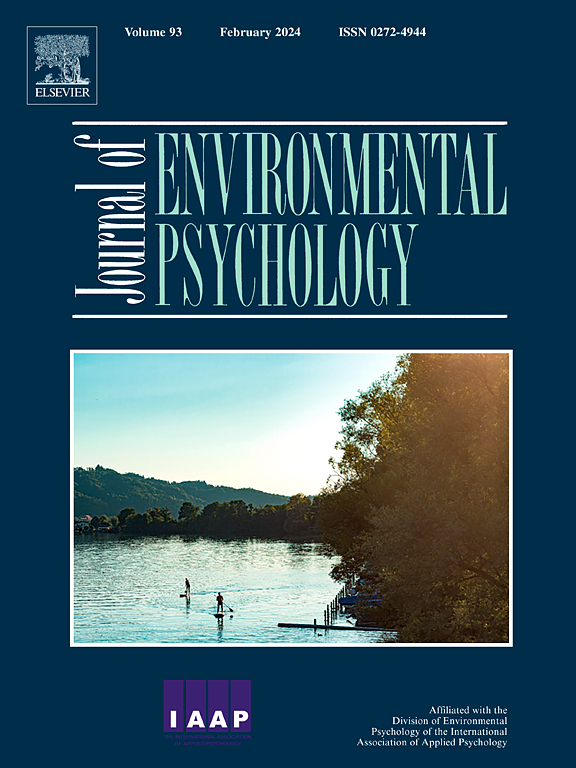Effects of outdoor walking and infant carrying on behavioral and adrenocortical outcomes in mothers and infants
IF 6.1
1区 心理学
Q1 ENVIRONMENTAL STUDIES
引用次数: 0
Abstract
Research in school-aged children demonstrates positive effects of outdoor walking on behavioral self-regulation. Furthermore, studies report stress-reducing effects of proximity on infants and mothers. To date, no studies have assessed the effects of an outdoor walk as well as infant carrying on infants and their mothers in the postnatal phase. This study assessed the effects of a 30-min walk in an outdoor green environment (vs. staying indoors) and proximity through infant carrying (vs. using a pram) on infants and their mothers. Effects on infant cortisol and sleep, maternal cortisol and mood, and mother-infant adrenocortical synchrony were examined. Infants (N = 101, 0–5 months old) were exposed to a mild naturalistic stressor. Mother-infant dyads were subsequently randomized to one of four conditions: walking in an outdoor green environment with the infant in a pram or a chest carrier, or staying indoors with the infant in a pram or a chest carrier. Mothers reported infant's sleep in minutes after the conditions, and maternal mood through visual analogue vigor and affect scales both immediately before and after the conditions. Cortisol concentrations of mother and infant were determined through five saliva samples throughout the experiment. After the stressor, carried infants showed a greater decrease in cortisol values compared to infants in the pram, regardless of whether they were walked outdoors or stayed indoors. Infants who were walked outdoors in a carrier or pram slept longer than infants who stayed indoors in a pram. In contrast, mothers staying indoors showed a greater decrease in cortisol concentrations as compared to mothers walking outdoors. Compared to mothers having their infant in a pram, mothers who carried their infant showed a greater decrease in cortisol concentrations. Indoors, maternal vigor decreased from the pre-to post-condition, while mothers going outdoors showed no decrease. There was no difference in maternal affect or mother-infant adrenocortical synchrony between conditions. Our findings have implications for caregiving advice, as well as for future research on the stress-reducing potential of the outdoors in combination with infant carrying.
求助全文
约1分钟内获得全文
求助全文
来源期刊

Journal of Environmental Psychology
Multiple-
CiteScore
10.60
自引率
8.70%
发文量
140
审稿时长
62 days
期刊介绍:
The Journal of Environmental Psychology is the premier journal in the field, serving individuals in a wide range of disciplines who have an interest in the scientific study of the transactions and interrelationships between people and their surroundings (including built, social, natural and virtual environments, the use and abuse of nature and natural resources, and sustainability-related behavior). The journal publishes internationally contributed empirical studies and reviews of research on these topics that advance new insights. As an important forum for the field, the journal publishes some of the most influential papers in the discipline that reflect the scientific development of environmental psychology. Contributions on theoretical, methodological, and practical aspects of all human-environment interactions are welcome, along with innovative or interdisciplinary approaches that have a psychological emphasis. Research areas include: •Psychological and behavioral aspects of people and nature •Cognitive mapping, spatial cognition and wayfinding •Ecological consequences of human actions •Theories of place, place attachment, and place identity •Environmental risks and hazards: perception, behavior, and management •Perception and evaluation of buildings and natural landscapes •Effects of physical and natural settings on human cognition and health •Theories of proenvironmental behavior, norms, attitudes, and personality •Psychology of sustainability and climate change •Psychological aspects of resource management and crises •Social use of space: crowding, privacy, territoriality, personal space •Design of, and experiences related to, the physical aspects of workplaces, schools, residences, public buildings and public space
 求助内容:
求助内容: 应助结果提醒方式:
应助结果提醒方式:


